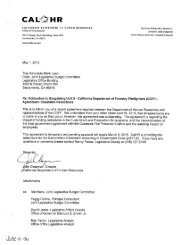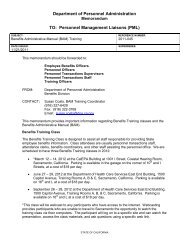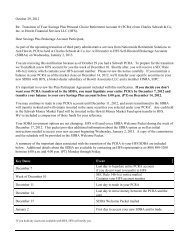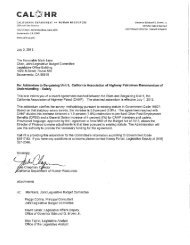Team Leadership - State of California
Team Leadership - State of California
Team Leadership - State of California
Create successful ePaper yourself
Turn your PDF publications into a flip-book with our unique Google optimized e-Paper software.
DRAFTEffective <strong>Team</strong>s: A Symptom <strong>of</strong> Healthy <strong>Leadership</strong>.The role <strong>of</strong> teams in modern organizations goes far beyond collaboration. Only withstrong leadership can the knowledge and skills <strong>of</strong> talented people be applied t<strong>of</strong>urther individual and organizational success. [ABSTRACT FROM AUTHOR]Authors: Crother-Laurin, CyndiSource: Journal for Quality & Participation 29, no. 3 (Fall 2006): 4Getting Results for the Hands On ManagerArticles and information about managing people.Publisher:American Management Association InternationalHarvard Management UpdateUse this publication to generate new ideas, understand management trends, andsolve current business problems by drawing on world-class research and real worldexpertise share the best ideas with colleagues and save each issue for easyreference.Publisher:Harvard Business School Publication Corp.How GE Teaches <strong>Team</strong>s to Lead Change.Previous PageIn 2006, General Electric launched its <strong>Leadership</strong>, Innovation, and Growth (LIG)program to support CEO Jeffrey Immelt's priority <strong>of</strong> achieving corporate growthprimarily by expanding businesses and creating new ones. LIG represented aradical approach for GE's famed management development center in Crotonville,New York, because it was the first effort to train all the senior members <strong>of</strong> a GEbusiness's management team as a group. Prokesch went through LIG with 19senior managers <strong>of</strong> GE Power Generation, one <strong>of</strong> the company's oldestbusinesses, in October 2007. About a year later he revisited the "turbine heads," asImmelt affectionately calls them, to see how much impact the program had made.The answer was a lot. <strong>Team</strong> training accelerated the pace <strong>of</strong> change by givingmanagers an opportunity to reach consensus on the barriers they faced and how toovercome them. LIG participants were encouraged to consider both hard(organizational) and s<strong>of</strong>t (behavioral) barriers. The training explicitly addressed howto balance the short term and the long term. The program created a commonvocabulary <strong>of</strong> change -- actual words that are used daily inside and across GE'sbusinesses. And LIG was not an academic exercise: It was structured so that aBack to Academic Journals and BooksNext PageHR Modernization Project <strong>Team</strong> <strong>Leadership</strong> - Page 10 Last Revision May 2011
















